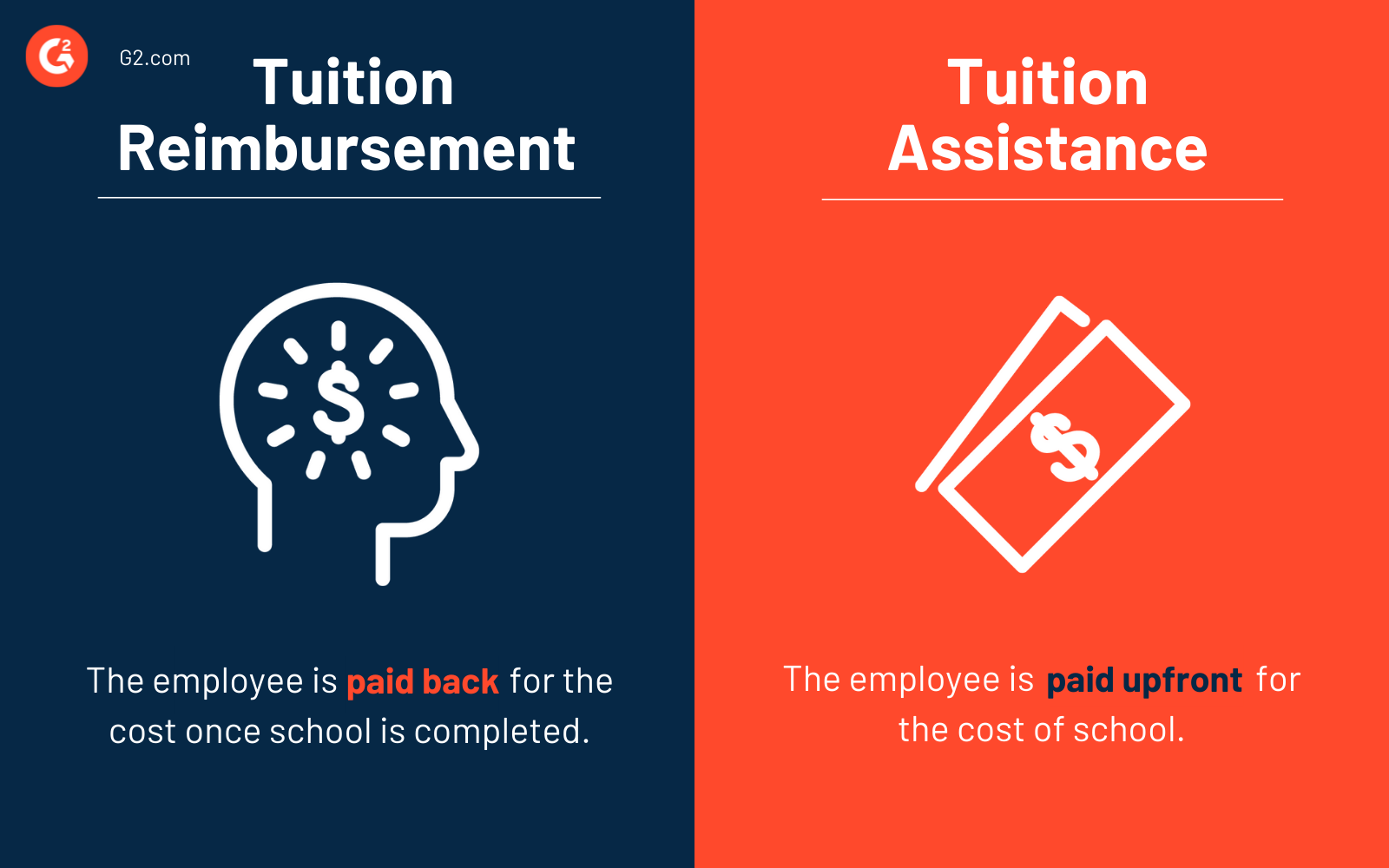You invest in your employees during the standard 9-5 workday.
You arm them with the best tools to do their jobs, a standing desk, and even healthy snacks at the office.
But what about outside of office hours? What can your company do to contribute more to the long-term success of your workforce? One way to do so is by offering a tuition reimbursement program that encourages further education and professional development.
What is tuition reimbursement?
Tuition reimbursement is a contractual agreement between an employer and an employee stating the company has agreed to pay to further the employee’s education, whether it be tuition or other education expenses. This benefit typically applies to both undergraduate degrees and graduate school.
The programs or courses an employer reimburses are intended for employees looking to advance their education related to their current or potential career track. This gives employees the chance to increase their industry knowledge and develop advanced skills to help the organization succeed.
Tuition reimbursement is often offered as an employee reimbursement or employee benefit in addition to a salary package and other benefits like healthcare, a 401(k), or transportation expenses. Companies typically use benefits administration software to plan and administer their benefits to ensure compliance with government regulations.
Tuition reimbursement plans are typically broken down into three areas of requirements:
- Program requirements: The colleges, universities, or institutions covered by the plan
- Coursework requirements: Courses eligible for reimbursement usually pertain to an employee's job description or potential career path
- Timeframe requirements: Whether or not an employee is required to continue working for the organization for a set amount of time after their education is complete
Tuition reimbursement vs. tuition assistance
It’s easy to confuse tuition reimbursement with tuition assistance or think they’re the same. However, there are specific differences between the two.

Tuition reimbursement is when a company repays an employee for school costs once completed or after each semester. Tuition assistance is when a company pays for the costs of attending school upfront. Tuition assistance is considered riskier because employers take the chance of an employee slacking off or not attending class, even though it’s already paid for.
Want to learn more about Benefits Administration Software? Explore Benefits Administration products.
How does tuition reimbursement work?
From covering tuition costs to reimbursing for books, your company’s tuition reimbursement plan can cover a lot of different elements. It’s important to make it work for your organization and your employees. Here are some elements to consider when building a program from the ground up.
Payment schedule
When organizations set up their program, a payment schedule needs to be outlined. Typically, employees pay for their classes upfront and submit tuition reimbursement forms once completed. Some employers may choose to pay for classes at the time an employee registers.
Course type
Usually, an employer only pays for courses or certificate programs related to the employee’s current role within the organization to continue their professional development. However, some businesses choose to include a high school diploma or GED program, in addition to a degree program, within their tuition reimbursement plan.
Payment levels
Some organizations have tiered payment levels within their tuition reimbursement program. For instance, an employer pays full-time employees for a certain percentage of the class, depending on their grades. Getting an A in a class would mean they qualify for 100% reimbursement of tuition costs, while a B may mean 85%, a C would mean 75%, and so on.
Expenses
Paying the expenses is another element to consider when creating a tuition reimbursement program. Some companies choose to cover only the cost of tuition, while others pay for continuing education costs like books, internet service, commuter fees, and any technology needed for class.
Institutions
Finally, many companies cover any accredited institutions, but it’s becoming more popular for employers to create exclusive partnerships with specific education providers. For example, if a local college or university offers a program valuable to many employees, your company may choose to partner with them.
How to create a tuition reimbursement program
As your human resources team creates a tuition reimbursement program, specific steps need to be included as part of the process.
Step 1: Run a cost-benefit analysis
As an HR professional, you may have to advocate for a tuition program by convincing others it’s worth the time, energy, and cost. It’s essential to make sure your company can afford to offer such a program and determine the benefits and potential drawbacks. It may be worth sending an employee survey to gauge the interest of the staff.
Step 2: Establish policies regarding enrollment and eligibility
Next, you’ll want to have clear details that go into who is eligible for the program and what is covered.
Below are questions that can help establish these rules and parameters:
- Is reimbursement available to all full-time employees across all departments?
- How long does an employee have to be within the company to be eligible?
- What degrees or programs are covered?
- Will the program include books and other fees, or only tuition?
Step 3: Partner with colleges and universities
Most programs don’t allow employees to choose from any school they’d like. It’s common for companies to partner with specific schools, colleges, and universities with a particular purpose in mind. Having a relationship with colleges in the area also makes filing paperwork a hassle-free experience for all parties involved.
Step 4: Create a marketing plan
Once the details are in place, it’s time to get everyone up to speed on what the program offers. If employees aren’t aware of the program, no one will sign up. Make sure department leaders properly fill in their team program details as part of proper benefits administration.
Also, provide messaging to recruiters on how to use the program as they look for top talent to join the organization.
Benefits of offering tuition reimbursement
Companies offer tuition reimbursement for various reasons, and there are benefits for both the employee and the employer. Here are some advantages to providing this type of program to your staff.
Recruiting tool to attract candidates
If your organization puts in the time and effort to create a tuition reimbursement program, show it off during the recruitment process!
This type of employee benefit could be what sets your business apart from the competition and may be the deciding factor for a candidate. By offering help with college tuition and student loans, you show just how invested you are in your team and the success of your organization.
Retain employees
Companies that offer tuition reimbursement have a better chance of reducing employee turnover as they retain top talent. Employees who have this benefit typically stay at a company longer, especially if there is a clause stating employees must remain at the organization for at least one year after completion.
Employees who take advantage of tuition reimbursement are likely to feel loyal to the organization and confident they can grow internally, instead of seeking career growth elsewhere.
Tax savings
Organizations that are hesitant about a tuition reimbursement plan because of the associated taxes should know it costs an employer very little. Any money a company spends on repaying tuition, or other educational expenses, for their employees is tax-deductible up to $5,250 per employee each year.
An education assistance program (EAP) must meet the following IRS criteria for tax savings:
- A written plan needs to be provided by the employer
- The plan can’t offer other benefits besides education
- An employee can’t receive more than $5,250 per year
- The plan cannot favor highly compensated employees
Develop talent to strengthen the company
A clearly defined employee tuition reimbursement program opens the door for more education opportunities, making internal talent more qualified to take on other roles. It’s smart to hire an internal candidate who already knows the ins and outs of the organization instead of trying to recruit a new candidate. And if an internal candidate has some, but not all, of the qualifications needed for a management role, going back to school for continued education can get them there.
For some employees, a college or graduate degree is the missing piece to be eligible for a promotion. The skills and knowledge their studies provide will help them be smarter, more efficient employees.
Jeremy Levin
Strategic CSM, G2
Employee engagement
Another key benefit of a tuition reimbursement program is that your staff never feels bored or at a stand-still in their role. Instead, they’ll feel encouraged to take on new challenges, follow their passions, and learn new skills to apply at work and in their personal lives.
Challenges of offering tuition reimbursement
It’s important to understand there are possible drawbacks to offering a tuition reimbursement program, too. Before you outline the ins and outs of what your organization will offer, keep these disadvantages in mind.
- Potential for burnout: Knowing how to balance work, a personal life, and everything that goes into taking a course can be challenging for employees. Managers should check on employees to see if their schooling affects their ability to focus or be productive at work.
- An abundance of paperwork: For every employee who takes advantage of this benefit, the human resources team is tasked with managing documents, receipts, and forms to ensure proper filing. This can be time-consuming and tedious if not done correctly.
- Significant investment in budget: Tuition reimbursement could eat up a lot of your budget, depending on how many employees enroll and how much of their tuition your organization funds. Consider running the policy by your financial team to make sure it’s something your business can afford.
Companies offering tuition reimbursement
If you’re considering offering tuition reimbursement, then you’re in good company. Check out these well-known brands that provide this benefit to their employees.
UPS
UPS offers the Earn & Learn Program, making it possible for part-time employees to receive up to $5,250 a year, with a lifetime maximum of $25,000, in tuition reimbursement. This covers any course of study at more than 100 nationwide colleges.
G2
Here at G2, we offer a variety of employee benefits, including tuition reimbursement. This benefit applies to full-time team members who have been a part of the company for at least three months and reimburses up to $5,250 a year.
It covers expenses like college courses, seminars, and certification tests that provide learning and growth in an area related to their current position within the company or to develop skills toward a new career opportunity with G2.
Casey Benson
Software Engineer, G2
Apple
Full-time employees at Apple can take advantage of Apple’s Education Reimbursement program, which offers up to $5,250 per year for education expenses. They also provide Apple University, an initiative aiming to help employees think like Steve Jobs.
Students of Apple University have access to classes, seminars, and tools on Apple’s company culture, personal finance, software skills, business skills, and more.
Disney
Disney offers full and part-time employees 100% of their tuition paid upfront, as long as it’s with a Disney Aspire network school. They offer a wide range of courses to build skills and pursue various degrees at undergraduate and graduate levels.
The courses within this program do not have to be related to the employee’s job at Disney.
Chipotle
Chipotle is another organization with a generous tuition reimbursement plan that covers 100% of the cost for select degrees, high school diplomas, and college prep courses. In addition, they provide employees up to $5,250 a year for a wider selection of programs and courses.
Deloitte
Employees at Deloitte can take advantage of Deloitte’s Graduate School Assistance Program, which reimburses full tuition for employees pursuing graduate school degrees. This program also includes a stipend for technology and discounts for graduate school entrance preparation courses, like the GMAT.
To be eligible for tuition reimbursement, employees agree to work for Deloitte for at least two years following the completion of graduate school.
McDonald’s
At McDonald’s, eligible employees can take part in the Archways to Opportunities program, which reimburses employees for approved courses at an accredited two or four-year college, a trade or vocational school, or graduate school.
To qualify, employees must work at a McDonald’s location where the franchise owner or operator participates in the program. Full-time restaurant managers who work at least 30 hours per week can get $3,000 of tuition reimbursed each year, while restaurant crew, part-time managers, or part-time office staff who work at least 15 hours per week can get $2,500 each year.
Knowledge is power
Offering your employees tuition reimbursement can go a long way in their personal and professional success. When your employees feel like your organization values their growth and wants them to be the best they can be, then everyone wins.
Now that you’ve created a tuition reimbursement program, what else can you offer your employees to be excited about? See how you can revamp your paid time off policy, too.

Mara Calvello
Mara Calvello is a Content and Communications Manager at G2. She received her Bachelor of Arts degree from Elmhurst College (now Elmhurst University). Mara writes customer marketing content, while also focusing on social media and communications for G2. She previously wrote content to support our G2 Tea newsletter, as well as categories on artificial intelligence, natural language understanding (NLU), AI code generation, synthetic data, and more. In her spare time, she's out exploring with her rescue dog Zeke or enjoying a good book.

